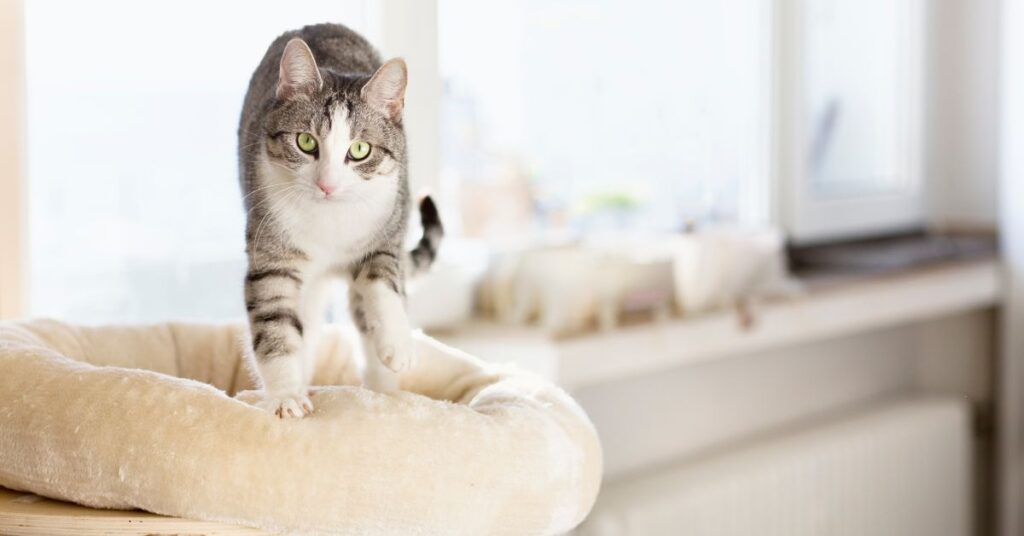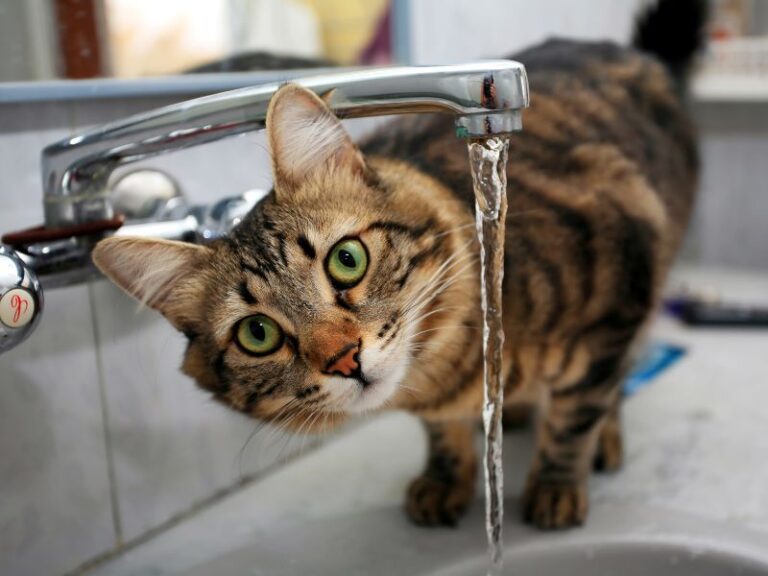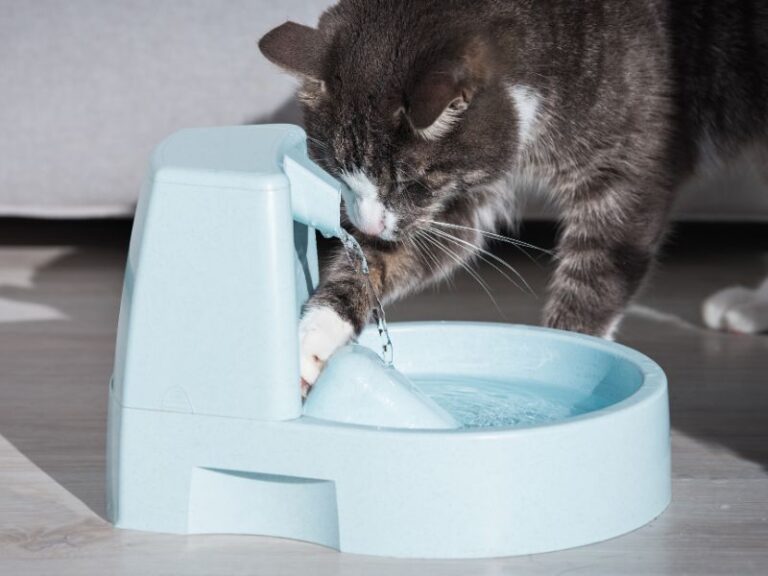Table of Contents
ToggleIf you’re a cat owner or have spent time around these enigmatic felines, you’ve likely witnessed the curious behavior of cats kneading. It’s a charming and somewhat perplexing action where a cat rhythmically pushes its paws in and out against a soft surface, often your lap or a cozy blanket. This endearing behavior can leave many cat owners wondering, “Why do cats knead?”
Understanding the reasons behind cats kneading goes beyond mere curiosity; it provides valuable insights into our furry companions’ emotions, instincts, and well-being. In this article, we’ll delve into the intriguing world of cats and their kneading behavior. We’ll explore the theories, the science, and the emotional connection behind this action, shedding light on why cats knead and why it’s important for us, as cat enthusiasts, to comprehend this unique behavior.
So, if you’ve ever found yourself puzzled by your purring friend’s kneading antics, join us on this journey of discovery, where we unravel the mysteries of “cats knead.”
What is Cat Kneading?
Cat kneading is one of those endearing behaviors that set our feline friends apart. But what exactly is cat kneading?
Cat kneading, often referred to simply as “kneading,” is a rhythmic and repetitive motion where a cat alternately pushes its front paws in and out against a soft surface. This behavior resembles the kneading of dough, hence the name. It’s a behavior most commonly observed in domestic cats but can also be seen in wild feline species.
The Ballet of Paws:
Imagine your cat, perched on your lap or nestled in a cozy spot, gently flexing and extending its front paws. Each paw movement is deliberate, akin to a miniature ballet, and it may seem as though your cat is massaging or “kneading” the surface beneath it. This action is often accompanied by a trance-like state, purring, and a look of contentment on your cat’s face.
The Why Behind “Kneading”:
The name “kneading” perfectly encapsulates the visual likeness of this behavior to a baker’s rhythmic motions while kneading dough. However, the true reasons behind why cats knead are a bit more complex and intriguing.
Theories and Explanations
The charming spectacle of a cat kneading can leave us both delighted and intrigued. But what motivates our feline companions to perform this rhythmic dance of paws? There are several theories and explanations, each shedding a different light on this captivating behavior.
- Nurturing Instinct: One prevailing theory suggests that kneading originates from a cat’s instinctive behavior as a kitten. Kittens knead their mother’s belly to stimulate milk flow during nursing. This comforting action is believed to be carried into adulthood, especially when cats are feeling relaxed or content.
- Territory Marking: Some experts propose that cats knead to mark their territory. The scent glands located between their paw pads release pheromones when they knead, leaving behind their unique scent. This territorial marking might serve as a way for cats to claim a space or object as their own.
- Comfort and Relaxation: Kneading is often associated with relaxation and contentment. Cats may knead to soothe themselves, much like humans use stress-relief techniques such as kneading dough or rubbing their temples. It’s their way of saying, “I’m safe and at ease.”
- Vestigial Behavior: Another intriguing theory posits that kneading is a vestigial behavior, harkening back to a time when wild cats would pat down grass or foliage to create a comfortable spot for rest or to check for potential threats.
- Emotional Bonding: Kneading can also be a sign of emotional bonding. Cats may knead their owners or other beloved companions as a way to show affection and establish a closer connection.
Insights from Studies
Several studies have explored cat behavior, including kneading. Researchers continue to uncover the nuances of this behavior, and while there’s no definitive answer, these studies contribute valuable insights into the psychology of cats.
Understanding these various theories and expert perspectives can help us appreciate the multifaceted nature of cats and their kneading behavior. In the following sections, we’ll dig deeper into the emotional connections and scientific aspects of why cats knead.
The Emotional Connection
Cats, with their enigmatic personalities, often communicate through subtle gestures. Kneading is one such gesture that conveys a world of emotion. It’s a behavior deeply intertwined with a cat’s emotional state, serving as a non-verbal expression of their feelings.
Contentment and Comfort
One of the most common scenarios where cats knead is when they’re feeling content and at ease. Picture your cat nestled beside you on a lazy Sunday afternoon, kneading your lap or a soft blanket. This is often a sign that your feline companion is in a state of bliss. The rhythmic motion of kneading mimics the soothing feeling of nursing from their mother as kittens, providing them with a sense of comfort and security.
Bonding and Trust
Cats also knead as a way to strengthen their bond with their owners or fellow feline companions. When a cat kneads you, it’s their way of saying, “I trust you, and I feel safe in your presence.” It’s a beautiful testament to the relationship between human and cat, a silent exchange of love and companionship.
Reducing Stress
Just as humans may engage in stress-relief activities like kneading dough or tapping their fingers when anxious, cats may knead to alleviate stress. The rhythmic motion is calming and can help them cope with various stressors in their environment.
Longing for Attention
Sometimes, cats knead as a subtle plea for attention. They may gently knead your arm or leg to remind you that they’re there, seeking your affection and companionship.
Understanding the emotional aspect of cat kneading allows us to connect with our feline friends on a deeper level. It’s a reminder that while cats may not express themselves in the same way humans do, their actions speak volumes about their emotions and the bonds they share with us.
The Science Behind Cat Kneading
While cat kneading is undeniably an emotional gesture, there’s also a physiological aspect to this mesmerizing behavior. It involves a delicate interplay of muscles and serves several potential benefits for our feline companions.
Muscle Coordination
Kneading engages multiple muscle groups in a cat’s front paws, including the flexor and extensor muscles. These muscles work together in a coordinated fashion as the cat pushes its paws in and out. It’s akin to a gentle workout for their forelimbs, promoting muscle strength and flexibility.
Paw Health
Kneading may help maintain paw health. The repeated flexing and extending of their claws during this motion can help keep their claws sharp and free from debris. In the wild, this could have been essential for survival, allowing them to grip prey or defend themselves effectively.
Reducing Stress and Anxiety
The rhythmic, repetitive nature of kneading has a calming effect on cats. This soothing motion can help reduce stress and anxiety, making it a natural coping mechanism for cats in various situations, from adjusting to a new environment to managing the presence of other animals.
Promoting Comfort and Relaxation
Kneading mimics the comforting sensation of nursing from their mother. As kittens, they kneaded their mother’s belly to stimulate milk flow. In adulthood, this behavior can evoke feelings of comfort and relaxation, helping cats feel safe and secure.
Do All Cats Knead?
Cat kneading is undoubtedly a captivating behavior, but it’s essential to recognize that not all cats engage in this charming ritual. Just as humans have unique habits and preferences, cats display a wide range of behaviors, and kneading is no exception.
Variation in Kneading Behavior
The propensity to knead varies from one cat to another. Some cats seem to be born “kneaders,” while others may rarely, if ever, exhibit this behavior. This variation isn’t unusual; it’s part of the rich tapestry of feline behaviors and personalities.
Factors Influencing Kneading
Several factors may influence whether a cat kneads or not, including:
- Early Life Experience: Cats that had a strong nurturing bond with their mother during kittenhood may be more inclined to knead in adulthood.
- Individual Temperament: Just as humans have different personalities, cats exhibit a wide range of temperaments. Some may be more predisposed to kneading than others.
- Environmental Comfort: Cats are creatures of habit, and their comfort levels in their environment play a significant role in their behavior. Cats feeling safe and content are more likely to knead.
Not Kneading is Normal
It’s essential to emphasize that the absence of kneading in a cat is entirely normal. Just as some cats may not enjoy being petted while others revel in it, kneading is a matter of individual preference. Whether your cat kneads enthusiastically or not at all, it’s a unique facet of their personality that should be celebrated.
How to Respond to Your Kneading Cat
When your cat starts kneading, it’s a moment of connection and trust. How you respond to this endearing behavior can deepen your bond and ensure your cat’s comfort.
Stay Calm and Relaxed
When your cat begins kneading, it’s a sign that they’re feeling safe and content. Maintain a calm and relaxed demeanor to reciprocate this sense of security. Softly stroke your cat or offer gentle words of affection to reinforce the positive experience.
Provide a Soft Surface
If your cat prefers kneading on a soft surface, such as your lap or a plush blanket, make sure to provide it. Cats often seek out these textures for kneading, so accommodating their preference contributes to their comfort.
Watch for Overstimulation
Kneading can sometimes escalate if a cat becomes overly excited or stimulated. Pay attention to your cat’s body language. If they start to knead more vigorously or exhibit signs of discomfort, such as flattened ears or a twitching tail, it may be time to give them some space.
Respect Their Boundaries
Just as with any interaction with your cat, it’s crucial to respect their boundaries. If your cat indicates that they’ve had enough by withdrawing or showing signs of irritation, allow them their personal space.
Enjoy the Moment
Kneading is a beautiful way for your cat to express their emotions and build a deeper connection with you. Take pleasure in these moments of closeness, as they strengthen the bond between you and your feline friend.
Remember that every cat is unique, and their preferences can vary. Some cats may enjoy extended kneading sessions, while others may prefer shorter, intermittent sessions. Understanding your cat’s comfort level and responding accordingly fosters a harmonious and loving relationship.
Final Words
In the world of feline behavior, few acts are as intriguing and heartwarming as cat kneading. This rhythmic ballet of paws, reminiscent of a kitten nursing or a baker kneading dough, carries a world of meaning for our beloved cats. Through this journey of exploration, we’ve uncovered the captivating secrets of why cats knead.
We began by defining cat kneading as the rhythmic motion of pushing their front paws against a soft surface. We delved into various theories and explanations, from nurturing instincts to territorial marking, offering insights from experts and studies. We unraveled the emotional connection behind kneading, understanding that it signifies contentment, bonding, and even stress relief for our feline companions.
From a scientific perspective, we explored the intricate muscular coordination involved in kneading and its potential benefits for cats, such as maintaining paw health and reducing stress. We acknowledged the variation in kneading behavior among cats, emphasizing that not all cats knead, and that’s perfectly normal.
Crucially, we discussed how to respond to your kneading cat, highlighting the importance of staying calm, providing a soft surface, and respecting their boundaries. This fosters trust and strengthens the bond between you and your furry friend.
In conclusion, cat kneading is a remarkable and multifaceted behavior that reveals the depth of our connection with these enigmatic creatures. It’s a testament to their trust, comfort, and individuality. So, the next time your cat begins their rhythmic dance of paws, cherish the moment. For in those moments, you’re witnessing not just a behavior, but a beautiful expression of your cat’s emotions and the unique bond you share.






